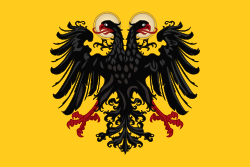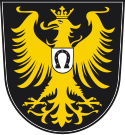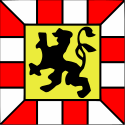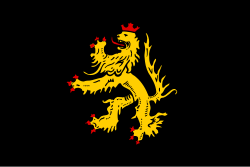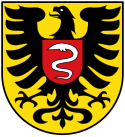Švábský městský spolek
| Schwäbischer Städtebund | |
|---|---|
| Účast na říšské válce | |
| Základní info | |
| Aktivní | 1376–1388 |
| Vznik jako | |
| Transformace | |
| Operační území | |
| Oponenti | |
| Konflikty/boje | říšská válka |

Švábský městský spolek (německy Schwäbischer Städtebund) byla středověká obranná vojenská aliance svobodných říšských měst ve Svaté říši římské na území bývalého Švábského vévodství, které zaniklo roku 1313. Městský spolek byl založen 4. července 1376, ale nebyl uznán císařem, protože ho považoval za snahu měst o povstání a proto již roku 1388 byl poražen spojenými silami Württemberska, Rýnské Falce a Norimberského purkrabství v bitvě u Döffingenu. Následujícího roku 5. května 1389 byl spolek rozpuštěn na základě rezoluce říšského sněmu zasedajícího v Chebu.
Roku 1488 císař Fridrich III. Habsburský založil nový Švábský spolek, ve kterém figurovalo mimo jiné i původních 26 členských říšských měst.
Seznam členů
Původních 26 zakládajících měst:
|
|
později se připojily:
| Roku 1380 se měli ke spolku připojit:
|
Související články
Média použitá na této stránce
Autor: David Liuzzo, eagle by N3MO, Licence: CC BY-SA 3.0
Banner of the Holy Roman Empire, double headed eagle with halos (1400-1806)
Autor: Photo: Andreas Praefcke, Licence: CC BY 3.0
Stuttgart, Chor der Stiftskirche, Grafenstandbilder von Sem Schlör (ab 1576 entstanden zum Ersatz der ursprünglichen Epitaphe der in der Stiftskirche beigesetzten Grafen von Württemberg)
Coat of arms of Isny
Autor: Spider, Licence: CC BY 3.0
Coat of arms of the town of Weil der Stadt. Blazon: Per pale, gules a bend sinister azure bearing letters SPQR and gules two keys in saltire or, in chief or an eagle displayed sable armed gules.
Coat of arms of Reutlingen
Wappen der Grossen Kreisstadt Wangen im Allgäu im Landkreis Ravensburg, Baden-Württemberg, Deutschland. Unter rotem Schildhaupt, darin drei linksgewendete bartlose silberne Männerköpfe (Wangen) nebeneinander, gespalten; vorne in Silber ein halber, rot bewehrter und rot bezungter schwarzer Adler am Spalt, hinten in Silber eine blaue Lilie.
Coat of arms of Friedrichshafen
Coat of arms of Biberach/Riss
Autor:
- National Coat of arms of Denmark.svg: Galico
- Derivate work: The White Lion
Arms of Swabia (or, lions passant sable)
Autor: --TECHNOKRAT (talk) 14:55, 2 October 2008 (UTC), Licence: CC BY-SA 3.0
Wappen der Burggrafen von Nürnberg - Eventuell das Wappen der Herren von Raabs
Wappen der Großen Kreisstadt Ravensburg im Landkreis Ravensburg, Baden-Württemberg, Deutschland
Banner of the Arms of the Duchy of Württemberg.
Autor: Stadt Konstanz, Licence: CC BY-SA 4.0
Historisches Wappen der Stadt Konstanz
Variant of the Standard of the Swabian League with an aspect ratio of 3:2.
Coat of arms of Nördlingen
Coat of arms of the Prince-Bishopric of Augsburg. Blazon: Per pale gules and argent.
